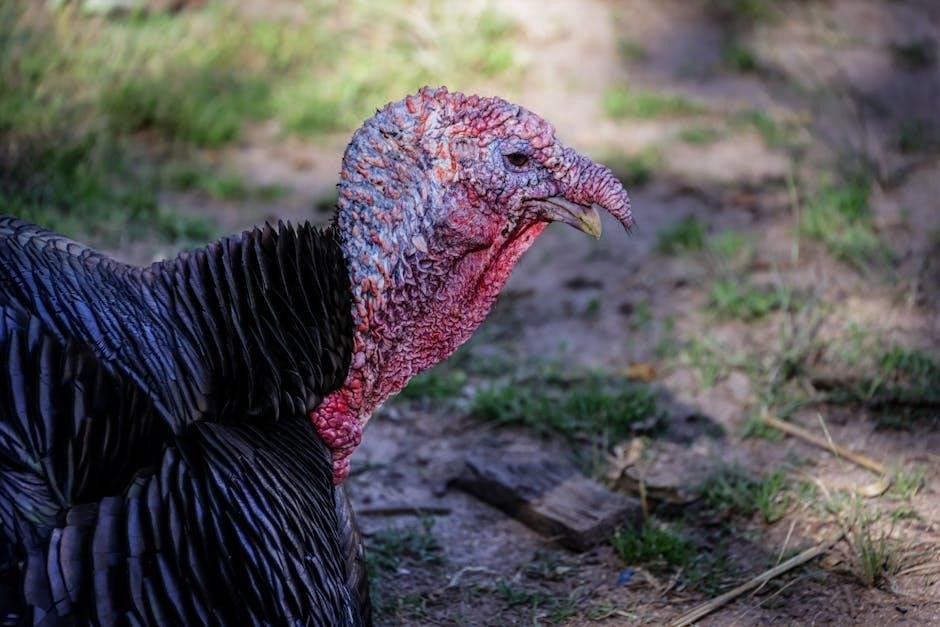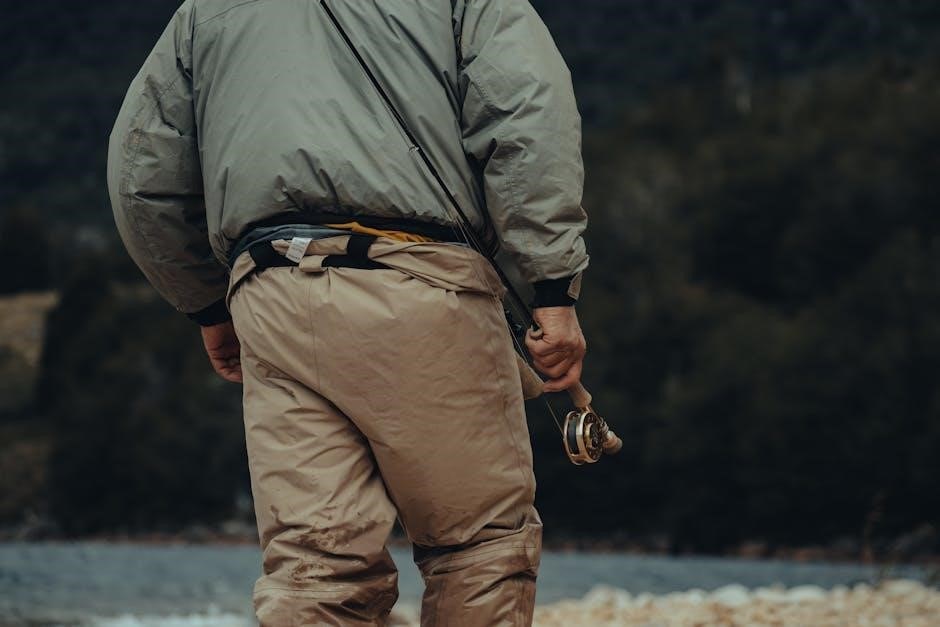birds of michigan field guide
Welcome to the world of bird watching in Michigan‚ a haven for nature enthusiasts! With over 400 species documented‚ Michigan offers a diverse birding experience. From vibrant warblers to majestic raptors‚ the state’s unique location on the Great Lakes makes it a critical stopover for migratory birds. Whether you’re a seasoned birder or just starting‚ Michigan’s scenic landscapes and abundant wildlife provide endless opportunities for discovery. Grab your binoculars and explore the beauty of Michigan’s feathered treasures!
Why Watch Birds in Michigan?
Michigan is a paradise for bird enthusiasts‚ offering a unique blend of diverse habitats and migratory pathways. Located on the Great Lakes‚ the state serves as a critical stopover for millions of migratory birds each year. With over 400 species documented‚ Michigan provides endless opportunities to spot rare and common birds alike. Bird watching here is not only a thrilling hobby but also a chance to connect with nature and learn about conservation efforts. The state’s scenic wetlands‚ forests‚ and coastal areas make it an ideal destination for both seasoned birders and newcomers. Whether you’re seeking adventure or relaxation‚ Michigan’s birding scene promises unforgettable experiences. Grab your binoculars and discover the beauty of Michigan’s avian wonders!
Michigan’s Best Birding Spots
Michigan boasts an array of exceptional birding locations‚ each offering unique opportunities to spot diverse species. Tawas Point‚ known for its concentrations of migratory birds‚ is a hotspot for warblers and raptors. Seney National Wildlife Refuge‚ with its wetlands and forests‚ is a haven for waterfowl and songbirds. Whitefish Point‚ a critical stopover for migratory birds‚ is renowned for its fall raptor migrations. The Upper Peninsula’s vast wilderness and coastal areas attract boreal species‚ while the Lake Erie shoreline is a key site for waterfowl and shorebirds. These locations‚ along with others‚ make Michigan a must-visit destination for bird enthusiasts. Whether you’re exploring marshes‚ forests‚ or coastlines‚ Michigan’s birding spots promise unforgettable experiences for all skill levels.
Diversity of Bird Species in Michigan
Michigan is home to over 400 bird species‚ ranging from waterfowl to songbirds‚ raptors‚ and shorebirds. Its location on the Great Lakes attracts migratory birds‚ creating a rich avifauna.
Common Backyard Birds in Michigan

Michigan’s backyards are frequented by a variety of bird species‚ making them a delight for birders. The American Robin‚ Black-capped Chickadee‚ and Northern Cardinal are year-round residents‚ often visiting feeders. The Blue Jay and American Goldfinch are also common‚ adding vibrant colors to backyard settings. Seasonal visitors like the Ruby-throated Hummingbird and Baltimore Oriole can be attracted with nectar feeders. Woodpeckers‚ such as the Downy and Hairy‚ are frequent visitors‚ especially to suet feeders. These birds bring life and beauty to residential areas‚ offering endless opportunities for observation and enjoyment. Field guides like Stan Tekiela’s Michigan bird guide can help identify these species and provide insights into their habits and preferences.
Seasonal Migrants and Wintering Birds
Michigan’s bird population changes dramatically with the seasons‚ attracting a wide variety of migratory species. Spring and fall bring an influx of warblers‚ sparrows‚ and raptors‚ while wintering birds like snow buntings and snowy owls arrive from the Arctic. Waterfowl such as ducks and geese are abundant during migration‚ utilizing Michigan’s wetlands and lakes as critical stopovers. The state’s location on the Great Lakes makes it a key destination for migratory birds seeking food and shelter. Field guides like Stan Tekiela’s Michigan bird guide highlight these seasonal visitors‚ offering insights into their habitats and behaviors. Tracking these birds through resources like the BirdCast Migration Dashboard can enhance your birding experience‚ helping you spot species as they pass through or winter in the state.
Endangered and Rare Bird Species
Michigan is home to several endangered and rare bird species that require special conservation efforts. The Kirtland’s Warbler‚ once on the brink of extinction‚ has seen a recovery thanks to targeted habitat management. The Piping Plover‚ a shorebird nesting along Lake Michigan’s beaches‚ remains critically endangered. Other rare species include the Whooping Crane and the Golden-winged Warbler; Field guides like Stan Tekiela’s Michigan bird guide provide detailed information on identifying these birds and their habitats. Conservation initiatives‚ such as habitat restoration and nesting site protection‚ are vital to ensuring the survival of these species. Birders are encouraged to report sightings of rare birds to aid in monitoring and protection efforts‚ making Michigan a key state for avian conservation.
Understanding Bird Migration in Michigan
Michigan’s location on the Great Lakes makes it a critical stopover for migratory birds. Millions of birds pass through annually‚ with peak migrations in spring and fall. Species like the Broad-winged Hawk and warblers rely on Michigan’s habitats for rest and refueling. The state’s diverse landscapes‚ from forests to wetlands‚ support a wide range of migratory patterns. Birders can track these movements using tools like the BirdCast Migration Dashboard‚ which provides live updates on bird movements. Key hotspots‚ such as the Straits of Mackinac‚ are renowned for their concentrations of migratory birds‚ making Michigan a paradise for observing this natural phenomenon.
Migration Patterns and Timing
Migratory birds in Michigan follow predictable patterns‚ with spring and fall being the peak seasons. Spring migration typically begins in late March‚ peaking in May‚ as birds return from southern wintering grounds. Species like warblers and tanagers arrive during this time‚ while waterfowl and raptors migrate earlier. Fall migration starts in late July‚ with songbirds moving south through September‚ and waterfowl following in October and November. Michigan’s location on the Great Lakes makes it a critical stopover for many species‚ such as the Broad-winged Hawk‚ which concentrates in large numbers before crossing the lakes. Timing varies by species‚ but birders can use tools like the BirdCast Migration Dashboard to track real-time movements and plan their outings to maximize sightings of these incredible birds.
Key Migration Hotspots in the State
Michigan boasts several key migration hotspots that attract birders from across the country. Tawas Point on Lake Huron is renowned for its concentrations of waterfowl and songbirds during spring and fall. Whitefish Point on Lake Superior is another prime location‚ especially for raptors like the Broad-winged Hawk‚ which funnels through in large numbers. The Upper Peninsula’s vast wilderness and coastal areas are critical stopovers for migratory birds. Additionally‚ locations like the Detroit River International Wildlife Refuge and the Sleeping Bear Dunes National Lakeshore offer exceptional opportunities to observe migratory species. These hotspots are enriched by Michigan’s unique geography‚ making them essential destinations for anyone eager to witness the marvel of bird migration.

Essential Tools for Bird Watching
A reliable field guide‚ binoculars‚ and a bird identification app are must-haves for Michigan birders. These tools enhance bird recognition and make every outing more enjoyable and productive.
Best Field Guides for Michigan Birds
Stan Tekiela’s field guide is a top choice for Michigan birders‚ featuring 112 species organized by color for easy identification. Another excellent option is the comprehensive guide with 513 color photographs covering 300 species. These guides provide detailed descriptions‚ habitat information‚ and maps of Michigan’s best birding spots. They are designed to help both beginners and experienced birders quickly identify species. The pocket-sized format of some guides makes them ideal for carrying during outings. These resources are indispensable for enhancing your birding experience and ensuring accurate identifications. Whether you’re exploring forests‚ wetlands‚ or backyards‚ a reliable field guide is your key to unlocking Michigan’s avian wonders.
Binoculars and Spotting Scopes
Binoculars are essential for bird watching‚ offering a closer view of Michigan’s diverse bird species. Look for models with 7x or 8x magnification for stability and clarity. Waterproof and lightweight designs are ideal for outdoor use. Spotting scopes are also valuable‚ especially for observing distant birds or those in open habitats like wetlands or grasslands. They provide higher magnification and are often used in combination with tripods for steady viewing. When choosing equipment‚ consider durability‚ image quality‚ and ease of use. These tools enhance your ability to study bird details‚ making identification more accurate and enjoyable. Whether you’re a novice or an experienced birder‚ the right optics can elevate your birding adventures in Michigan.
Bird Identification Apps
Bird identification apps are invaluable tools for Michigan birders‚ offering instant access to species information. Apps like Merlin Bird ID and iBird Pro use AI and comprehensive databases to help identify birds based on photos‚ calls‚ or descriptions. Merlin Bird ID‚ developed by Cornell Lab of Ornithology‚ is particularly popular for its user-friendly interface and accuracy. iBird Pro boasts extensive species coverage and high-quality images. These apps often include range maps‚ nesting times‚ and behavioral insights‚ making them essential for both beginners and experienced birders. They also allow users to track sightings and connect with birding communities. By leveraging technology‚ birders can enhance their field guide experience and make identification more efficient and enjoyable in Michigan’s diverse birding landscapes.

Common Bird Species in Michigan
Michigan is home to a wide variety of bird species‚ including year-round residents like the American Robin and Black-capped Chickadee‚ as well as migratory visitors. The state’s diverse habitats attract waterfowl‚ songbirds‚ and raptors‚ making it a hotspot for birding enthusiasts. With over 400 documented species‚ Michigan offers a rich experience for bird watchers to explore and discover its feathered treasures throughout the seasons.

Year-Round Residents
Michigan is home to a variety of bird species that remain in the state throughout the year‚ adapting to its changing seasons. The American Robin‚ Black-capped Chickadee‚ and Blue Jay are familiar sights in backyards and woodlands. These birds thrive in diverse habitats‚ from urban areas to forests‚ and are known for their distinctive calls and behaviors. The Downy Woodpecker and Tufted Titmouse are also common residents‚ often visiting bird feeders. Year-round residents play a vital role in Michigan’s ecosystems‚ contributing to seed dispersal and insect control. Their presence offers birders consistent opportunities for observation and enjoyment‚ making them a cornerstone of the state’s avifauna.
Spring and Fall Migrants
Michigan’s strategic location on the Great Lakes makes it a critical stopover for migratory birds. During spring and fall‚ the state witnesses an influx of species traveling between their breeding and wintering grounds. Warblers‚ tanagers‚ and orioles are among the most colorful migrants‚ drawing birders to hotspots like the Upper Peninsula and Lake Erie shorelines. The American Redstart‚ Scarlet Tanager‚ and Cape May Warbler are highlights of these migrations. These birds rely on Michigan’s habitats for rest and refueling‚ making their passages a thrilling spectacle. Birders and conservationists closely track these movements‚ as they provide insights into migration patterns and the health of bird populations. The state’s diverse landscapes support a wide variety of migratory species‚ ensuring a dynamic and ever-changing birding experience throughout the seasons.
Waterfowl and Shorebirds
Michigan’s wetlands‚ lakes‚ and coastal areas are magnets for waterfowl and shorebirds‚ offering a rich variety of species to observe. Ducks‚ geese‚ herons‚ and sandpipers are among the most common sightings. The American Black Duck‚ Wood Duck‚ and Mallard are popular waterfowl‚ while shorebirds like the Semipalmated Plover and Killdeer frequent beaches and mudflats. These birds thrive in Michigan’s diverse aquatic habitats‚ from marshes to open waters. Birders can spot them during migration or breeding seasons‚ with many species relying on these areas for feeding and nesting. Field guides like Stan Tekiela’s are invaluable for identifying these birds‚ as they often appear in similar habitats. Whether wading in shallow waters or flying in formation‚ waterfowl and shorebirds add dynamic beauty to Michigan’s birding scenes.
Birding by Habitat in Michigan
Michigan’s diverse habitats‚ from forests to wetlands and grasslands‚ support a wide range of bird species. Field guides help identify birds in each unique environment.
Forest Birds
Michigan’s forests are a prime habitat for a variety of bird species. The Black-capped Chickadee‚ Red-breasted Nuthatch‚ and Pileated Woodpecker are common residents. These birds thrive in wooded areas‚ where they forage for insects‚ seeds‚ and nuts. Field guides highlight their unique calls and plumage‚ making identification easier. The Ruffed Grouse‚ with its distinctive drumming‚ and the Ovenbird‚ known for its “teacher-teacher-teacher” song‚ are also forest dwellers. Warblers‚ such as the Blackburnian and Yellow-rumped‚ migrate through Michigan’s forests‚ adding to the diversity. Birders can explore both deciduous and coniferous forests to spot these species. Using binoculars and field guides enhances the experience‚ helping enthusiasts appreciate the rich avifauna of Michigan’s wooded landscapes.
Wetland and Lake Birds
Michigan’s wetlands and lakes are vital habitats for a wide variety of bird species. Waterfowl like ducks‚ geese‚ and herons thrive in these areas‚ while shorebirds such as sandpipers and plovers frequent the lake shores. The American Bittern and Great Egret are iconic wetland residents‚ known for their stealthy movements and graceful forms. Field guides highlight their unique plumage and behaviors‚ aiding in identification. Michigan’s wetlands also serve as critical stopovers for migratory birds‚ offering refuge and feeding grounds. Birders can explore marshes‚ bays‚ and lake edges to spot these species. Using binoculars and field guides enhances the experience‚ allowing enthusiasts to fully appreciate the rich diversity of Michigan’s wetland and lake birds.
Grassland and Prairie Birds
Michigan’s grasslands and prairies are home to a unique array of bird species that thrive in open‚ expansive habitats. Birds like the Eastern Meadowlark‚ Bobolink‚ and Upland Sandpiper are common sights‚ their vibrant songs filling the air. These areas are particularly important for ground-nesting species‚ such as the Greater Prairie-Chicken‚ which relies on tallgrass prairies for breeding. Field guides often highlight the distinctive plumage and behaviors of these birds‚ making identification easier for enthusiasts. Grasslands also serve as vital stopovers for migratory birds‚ offering food and shelter. Conservation efforts are crucial to protect these habitats‚ as many grassland bird populations face threats from habitat loss. Exploring Michigan’s prairies with binoculars and a field guide can reveal the rich diversity of these open-country birds.

Conservation Efforts in Michigan
Michigan’s conservation initiatives focus on protecting bird habitats and promoting sustainable practices. Local organizations‚ like the Michigan Audubon Society‚ work tirelessly to restore wetlands and forests‚ ensuring safe havens for native and migratory species. Public awareness campaigns and community involvement are key to safeguarding Michigan’s avian diversity for future generations.

Protecting Bird Habitats
Protecting bird habitats in Michigan is crucial for maintaining avian diversity. Wetlands‚ forests‚ and grasslands are vital ecosystems that support breeding‚ feeding‚ and migration; The Michigan Audubon Society and local conservation groups work to restore and preserve these habitats‚ ensuring safe havens for both resident and migratory birds. Wetlands‚ in particular‚ are essential for waterfowl and shorebirds‚ while forests provide nesting grounds for warblers and raptors. Grasslands support species like meadowlarks and sparrows. Urbanization‚ climate change‚ and invasive species threaten these habitats‚ making conservation efforts imperative. By promoting sustainable land management and community involvement‚ Michigan can safeguard its bird populations for future generations. These initiatives are vital for the state’s ecological balance and biodiversity.
Local Organizations and Initiatives
Michigan is home to numerous organizations dedicated to bird conservation and education. The Michigan Audubon Society plays a key role in protecting habitats and promoting birding through events and advocacy. The Michigan Sea Grant supports bird-friendly initiatives along the Great Lakes shoreline‚ focusing on waterfowl and migratory species. Local birding clubs‚ such as the Kalamazoo Nature Center and Detroit Audubon‚ organize workshops‚ field trips‚ and citizen science projects. These groups often collaborate with state agencies to monitor bird populations and address threats like habitat loss. Community-driven initiatives‚ such as bird counts and nesting box programs‚ engage residents in conservation efforts. By supporting these organizations‚ Michiganders can contribute to the preservation of avian diversity and enjoy the benefits of birding for generations to come.
Birding Events and Festivals
Michigan hosts annual birding festivals‚ attracting enthusiasts nationwide. Events feature guided tours‚ workshops‚ and expert talks‚ celebrating the state’s avian diversity and fostering community engagement among birders.

Annual Birding Festivals
Michigan’s annual birding festivals are a celebration of its rich avian diversity. Events like the Michigan Bird Festival and the Great Lakes Bird Fest attract birders from across the country. These festivals typically feature guided birding tours‚ expert lectures‚ and interactive workshops. Participants can explore Michigan’s key habitats‚ from wetlands to forests‚ and spot rare species. Many festivals also include photography contests‚ bird-banding demonstrations‚ and family-friendly activities. These events are perfect for both seasoned birders and newcomers‚ offering a chance to connect with nature and like-minded enthusiasts. By attending‚ visitors support conservation efforts and gain deeper insights into Michigan’s birding culture. Mark your calendar for these exciting gatherings that highlight the state’s feathered treasures!
Workshops and Classes for Beginners
Michigan offers excellent workshops and classes designed for those new to bird watching. These programs‚ often hosted by local organizations like Michigan Sea Grant‚ provide a fun and educational introduction to the hobby. Participants learn essential skills such as bird identification‚ binocular use‚ and field guide navigation. Hands-on activities‚ like guided nature walks and bird-banding demonstrations‚ give beginners real-world experience. Many classes also cover the basics of bird behavior‚ habitat‚ and migration patterns. With expert instructors and a supportive environment‚ these workshops are perfect for building confidence and knowledge. They’re a great way to connect with fellow birders and gain the tools needed to enjoy Michigan’s vibrant birding scene. Whether you’re exploring backyard birds or venturing into the wild‚ these classes are an ideal starting point for your birding journey.
Bird watching in Michigan is a rewarding hobby‚ offering diverse species and scenic habitats. With field guides like Stan Tekiela’s‚ enthusiasts can easily identify and explore Michigan’s avian wonders. From backyard birds to migratory visitors‚ the state’s rich birdlife promises endless discovery. Whether you’re a seasoned birder or just starting‚ Michigan’s natural beauty and vibrant bird communities ensure unforgettable experiences. Grab your binoculars‚ embrace the outdoors‚ and enjoy the fascinating world of Michigan’s birds!
Final Tips for Michigan Birders
To enhance your birding experience in Michigan‚ always carry a reliable field guide‚ such as Stan Tekiela’s‚ for quick identification. Invest in quality binoculars and consider a spotting scope for distant observations. Download bird identification apps to recognize species by sight or sound. Stay updated with migration patterns using tools like the BirdCast Migration Dashboard. Join local birding groups or attend workshops to learn from experts and gain insights. Be patient and observant‚ as birds can be unpredictable. Respect habitats and follow ethical birding practices to ensure their safety. Keep a life list to track your sightings and celebrate your discoveries. Finally‚ enjoy the beauty of Michigan’s diverse birdlife and the joy of connecting with nature!

Resources for Further Learning
For deeper exploration of Michigan’s birdlife‚ consider essential resources like Stan Tekiela’s field guide‚ featuring 112 species tailored to the state. The BirdCast Migration Dashboard offers live tracking of migratory patterns‚ while eBird provides real-time sightings and data. Bird identification apps‚ such as those with song recognition‚ are invaluable for field use. Michigan Sea Grant’s educational classes and workshops are perfect for beginners. Additionally‚ local birding festivals and events connect enthusiasts with experts. Online forums and communities‚ like the Michigan Birding Facebook group‚ share insights and updates. Lastly‚ the Michigan Birdwatching: A Beginner’s Field Guide is a concise resource for identifying common species. These tools will enhance your birding journey and keep you informed about Michigan’s avian wonders.

























































